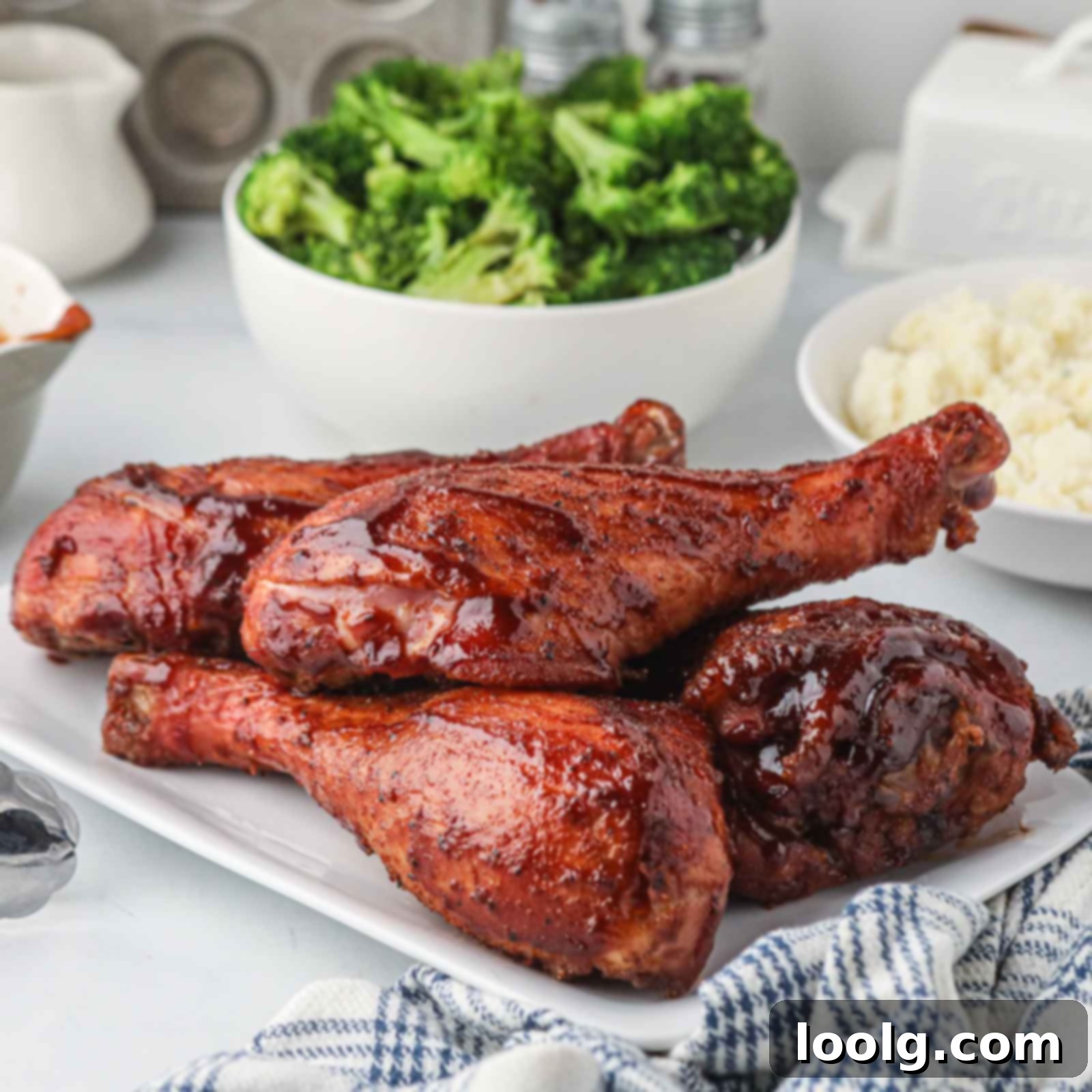Perfectly Smoked Turkey Legs: A Guide to Juicy, Flavorful Drumsticks
Smoked turkey legs are an absolute delight for any barbecue enthusiast, backyard chef, or holiday host looking to impress. These succulent, flavorful turkey drumsticks are far more than just fairground novelties; they are a culinary experience, offering tender, smoky meat that practically falls off the bone. Surprisingly easy to master, even for those new to the world of meat smoking, this recipe also caters to various dietary needs, being effortlessly adaptable for gluten-free, dairy-free, and paleo lifestyles.
Imagine the irresistible aroma filling your backyard or kitchen, reminiscent of those unforgettable turkey legs enjoyed at state fairs or theme parks. The rich, perfectly smoked meat, infused with deep flavor and often glazed with a bold, savory-sweet barbecue sauce, promises a memorable meal every time. Whether you’re planning a casual summer BBQ, a festive holiday feast, or simply want to elevate your everyday cooking, smoked turkey legs are a show-stopping, flavor-packed choice.
If you’re exploring more smoked turkey options for the holidays or a larger gathering, you might also enjoy a flavorful Smoked Turkey Breast for a leaner option, or a traditional Traeger Smoked Turkey recipe that can be adapted for any pellet smoker. This particular guide, however, focuses on the glorious turkey leg, celebrated for its dark, juicy meat and robust flavor profile.
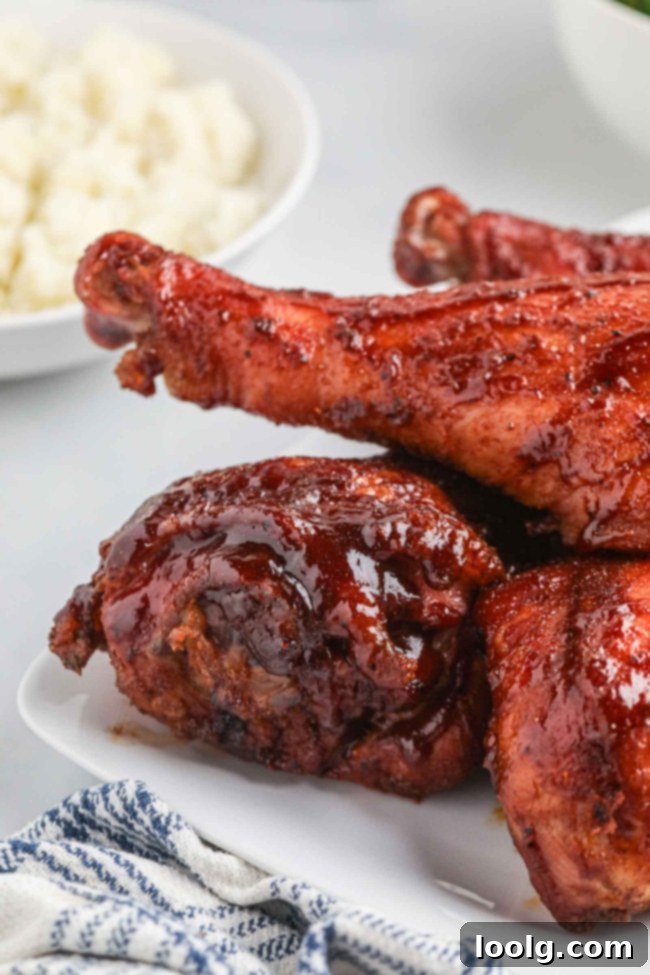
Essential Ingredients for Smoked Turkey Legs
Crafting the perfect smoked turkey leg begins with selecting the right ingredients. Here’s a detailed look at what you’ll need, starting with the crucial brine components, which lay the foundation for flavor and moisture.
The Brine: The Secret to Juicy Turkey Legs
Brining is a game-changer for smoked turkey legs. It’s a simple step that guarantees your drumsticks remain incredibly juicy and tender throughout the long smoking process, while also infusing them with deep flavor.
- Kosher salt – This is the preferred salt for brining due to its larger crystal size and lack of iodine, which can sometimes impart an off-flavor. Kosher salt penetrates the meat effectively, helping to break down muscle fibers and ensure a tender texture while seasoning it from within. If using table salt, be mindful of anti-caking agents and iodine; opt for a pure, non-iodized variety for best results. Always measure salt by weight for accuracy.
- Brown sugar – Beyond adding a delightful touch of sweetness, brown sugar aids in the Maillard reaction during smoking, contributing to that beautiful golden-brown, caramelized crust. Its molasses content adds a subtle depth of flavor that complements the smoky notes. For a paleo-friendly version, coconut sugar is an excellent substitute, offering a similar sweetness and caramelization.
- Bay leaves – These aromatic leaves provide a subtle, earthy, and slightly floral backdrop to the brine. They contribute a layer of savory complexity that enhances the overall flavor of the turkey without overpowering it.
- Whole black peppercorns – Offering a mild, pungent spice, whole black peppercorns add a nuanced warmth and complexity to the brine. Their aroma becomes more pronounced during the smoking process, further enriching the turkey’s flavor profile.
- Water – As the base of the brine, water dissolves the salt and sugar, allowing the flavor compounds to penetrate deeply into the turkey meat.
- Ice water – Crucial for quickly cooling the brine after simmering. It’s vital to ensure the brine is completely chilled before adding the turkey legs to prevent bacterial growth and keep the meat safe.
The Turkey Legs and Seasonings
Once the brine has worked its magic, the turkey legs are ready for their flavorful journey into the smoker.
- Turkey legs – For dark meat lovers, these drumsticks are a dream come true. Look for fresh, plump turkey legs, ideally of similar size to ensure even cooking. Their rich, savory meat stands up exceptionally well to the low and slow smoking process.
- Olive oil – A light coating of olive oil serves multiple purposes. It helps the BBQ rub adhere evenly to the skin, promotes a crispy exterior, and locks in moisture, preventing the turkey legs from drying out during the long smoke.
- All-purpose BBQ rub – This is where you infuse a significant layer of flavor into the turkey’s exterior. Whether you prefer a sweet, savory, spicy, or herby blend, a good BBQ rub will form a delicious crust. If you don’t have a go-to favorite, you can use a trusted recipe like the one I utilized for my Smoked Turkey Breast, which offers a balanced profile perfect for poultry.
- Applewood pellets – The choice of wood plays a pivotal role in the final smoky flavor. Applewood is a fantastic choice for poultry, offering a mild, subtly sweet, and fruity smoke that enhances the turkey without overwhelming it. Other excellent options include cherry for a sweeter, fruitier finish and beautiful mahogany color, or hickory and mesquite for a bolder, more intense smoky taste.
- BBQ sauce – Applied towards the end of the smoking process, BBQ sauce creates a beautiful, sticky, and glossy glaze. It adds a final punch of savory-sweet flavor, contributing to that classic, irresistible smoked turkey leg experience. Choose a sauce that complements your rub and preferred flavor profile.
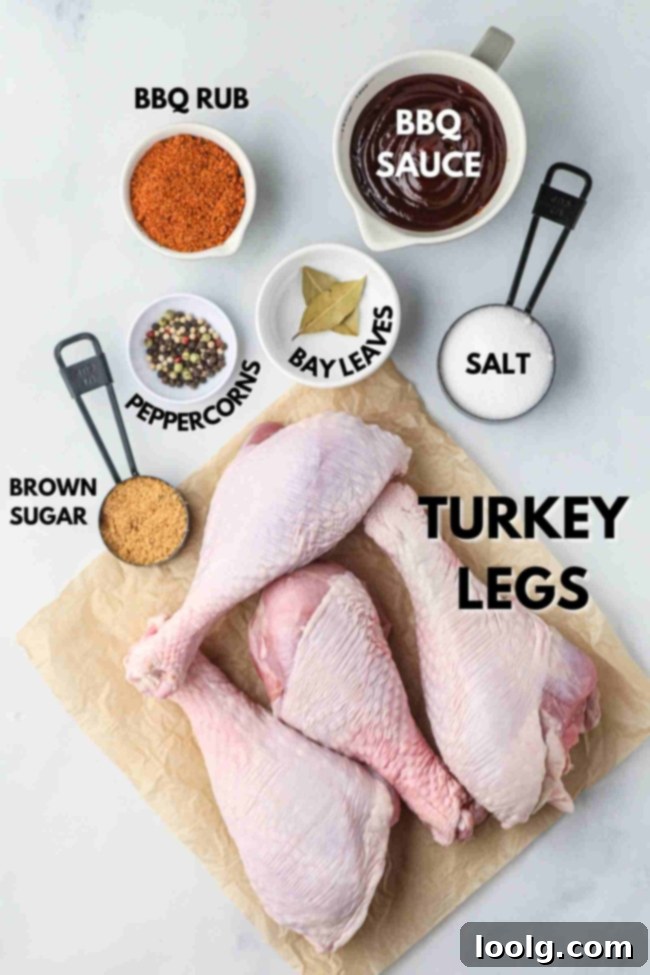
As an Amazon Associate, I earn from qualifying purchases. For more info, see my disclosure.
Selecting Your Rubs and BBQ Sauces
For those new to the art of smoking meat or simply looking for tried-and-true recommendations, having a few favorite rubs and BBQ sauces on hand can make all the difference. These selections pair beautifully with turkey drumsticks, ensuring a rich, complex flavor profile.
Recommended BBQ Rubs for Poultry
A good rub creates the foundation of flavor and helps develop that enticing “bark” on the exterior of your smoked turkey legs.
- Killer Hogs The BBQ Rub – This rub offers a perfectly balanced blend of sweet and savory notes, with just a hint of spice. It’s exceptionally versatile and works wonders on poultry, helping to create a delicious caramelized crust that locks in moisture and flavor.
- Meat Church Holy Gospel BBQ Rub – A highly versatile rub known for its bold mix of sweet, savory, and a touch of heat. It’s a fantastic choice for turkey, adding significant depth and complexity to the meat’s natural flavor.
- Traeger Fin & Feather Rub – Specifically formulated for poultry and fish, this rub features light citrus and herb undertones. It beautifully complements the milder smokiness produced by applewood or cherry pellets, creating a bright yet savory profile.
- Plowboys Yardbird Rub – A perennial crowd-favorite for all types of poultry. It delivers a delightful sweet and slightly smoky flavor that truly enhances the turkey, making it incredibly appealing to a wide range of palates.
Delicious BBQ Sauces to Elevate Your Smoked Turkey
The right BBQ sauce can transform your smoked turkey legs, adding a sticky, sweet, and tangy glaze that’s utterly irresistible. Apply it towards the end of the smoking process for optimal caramelization.
- Stubb’s Original BBQ Sauce – A classic Texas-style sauce that’s tangy, savory, and not overly sweet, made with natural ingredients. It enhances the smoky flavor of the turkey without overpowering it, perfect for those who appreciate a more traditional BBQ taste.
- Sweet Baby Ray’s Hickory & Brown Sugar BBQ Sauce – If you enjoy a sweeter glaze with a pronounced smoky aroma, this is an excellent choice. Its rich, sugary profile caramelizes beautifully on the turkey legs, creating a delectable finish.
- Blues Hog Original BBQ Sauce – This sauce is thick, rich, and sweet, balanced with a distinctive tangy kick. It’s a top pick for achieving a luxurious, glossy, and intensely flavorful finish on your turkey legs.
- Traeger ‘Que BBQ Sauce – Designed specifically for use with pellet smokers, this sauce offers a mildly sweet and tangy profile. It’s a perfect match for smoked turkey, adding a harmonious layer of flavor that complements the wood smoke.
Understanding Salt Conversion for Brining
Achieving consistent and perfectly seasoned results in brining hinges on accurate salt measurement. It can be frustrating when recipes simply state “salt” without specifying the type, as different salts have distinct textures and densities, which significantly impact the final flavor and salinity of your brine.
For this recipe, we emphasize the importance of measuring your salt by weight rather than volume. A cup of fine table salt will weigh more and therefore be saltier than a cup of coarse Kosher salt. To ensure optimal results and avoid over-salting (or under-salting) your turkey legs, a kitchen scale is your best friend.
For the brine, if measuring by volume, you can use:
- ½ cup Morton Coarse Kosher Salt
- 14 tablespoons Diamond Crystal Kosher Salt
- 6 tablespoons table salt.
However, for the most precise and consistent results, simply weigh it! You’ll need 125 grams of salt for this brine, regardless of the type, making the process foolproof.
How to Smoke Turkey Legs: A Step-by-Step Overview
Smoking turkey legs is a journey that transforms simple drumsticks into incredibly tender, juicy, and flavorful masterpieces. Here’s an overview of the key stages in making these delicious smoked turkey legs, focusing on the techniques that deliver exceptional results.

The smoking process typically involves a period of low and slow cooking to infuse the meat with smoke, followed by a higher temperature finish, especially after applying BBQ sauce. This final blast of heat serves several crucial purposes:
- Caramelization and Glaze: The higher temperature helps the sugars in the BBQ sauce caramelize. This creates a beautifully sticky, glossy glaze on the turkey legs, enhancing both their visual appeal and flavor with a slightly sweet, smoky crust. This is where the “magic” of a classic BBQ finish truly comes to life.
- Crispness and Texture: This step also adds a slight crispness to the outer layer of the turkey legs. This textural contrast between the slightly crisp skin and the incredibly tender, juicy meat inside is a hallmark of perfectly smoked poultry.
- Enhanced Appearance: Beyond flavor and texture, caramelization gives the turkey legs a rich, dark mahogany color that is incredibly appetizing and looks professionally prepared.
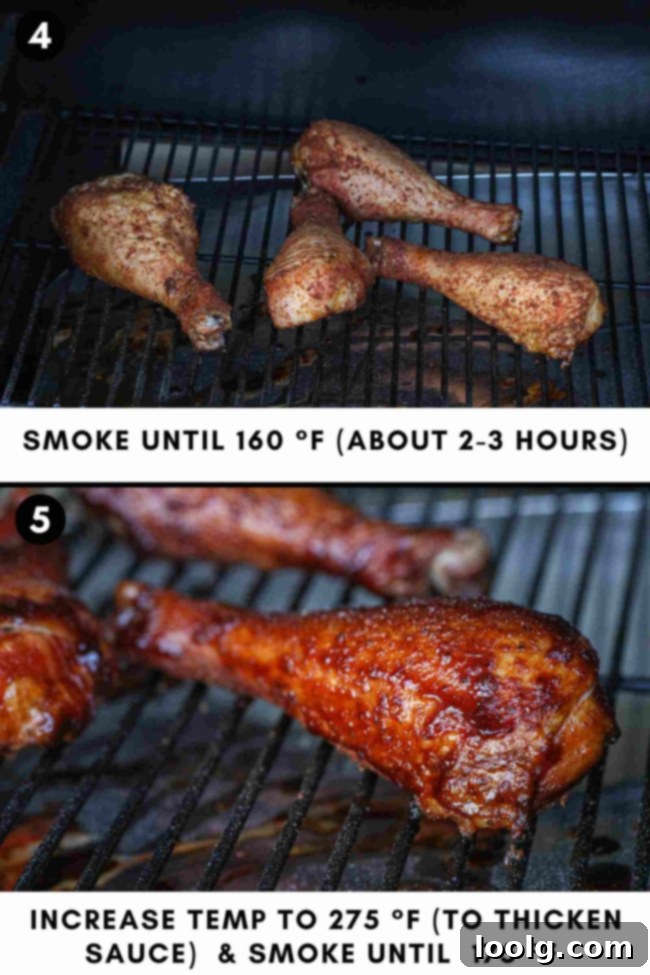
It is absolutely essential to use a reliable meat thermometer for all smoked recipes. Relying solely on visual cues like color or estimated cooking times can be misleading, as turkey legs can vary significantly in size and your smoker’s temperature can fluctuate. An accurate thermometer ensures your turkey reaches the safe internal temperature for doneness while remaining perfectly juicy. For comprehensive, detailed step-by-step instructions, please scroll down to the full recipe card at the bottom of the page.
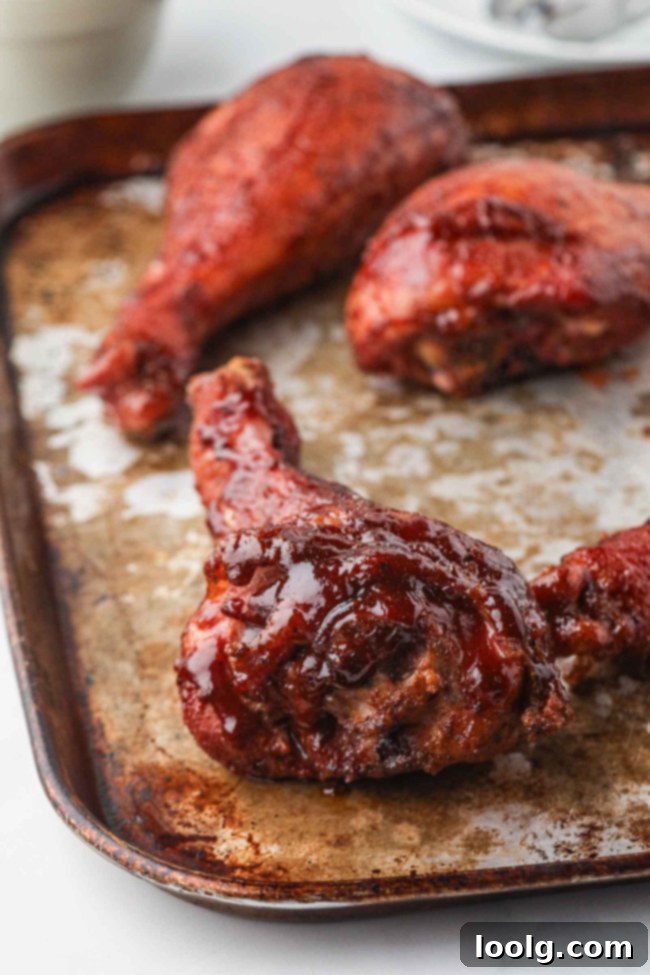
Detailed Smoking Timeline for Perfect Turkey Legs
Smoking turkey legs is an art that benefits from a well-planned timeline, especially for special occasions like Thanksgiving. While cooking times can vary based on your specific smoker model, the consistency of its temperature, and the number and size of turkey legs you’re smoking, having a general schedule will guide you to success. For perfectly cooked turkey legs every single time, an accurate food thermometer is not just a recommendation—it’s a must-have tool.
Allowing the turkey legs to rest after smoking is equally important. This step, often overlooked, allows the juices within the meat to redistribute, ensuring every bite is as succulent as possible. Remember, if you are starting with frozen turkey legs, proper thawing in the refrigerator is crucial. Never attempt to smoke partially frozen meat, as it will cook unevenly and can pose food safety risks. Ensure they are completely thawed before beginning the brining process.
Here’s a sample timeline designed to have your delicious smoked turkey legs ready to serve by 12 p.m. on Thanksgiving or any special day:
Day Before Serving: Brining for Maximum Flavor and Juiciness
- Between 6:00 p.m. and 10 p.m. (or earlier for a longer brine) – Prepare your brine according to the recipe instructions, ensuring it is completely cooled. Place the turkey legs in a large brining bag or a non-reactive container, then pour the cooled brine over them, making sure they are fully submerged. Refrigerate the turkey legs for at least 6 to 8 hours. For optimal flavor penetration and maximum tenderness, brining overnight (10-12 hours) is highly recommended. If you desire a 24-hour brine, simply start the process around 6 a.m. the day before serving.
Day of Serving: Smoking to Perfection
- 6:00 a.m. to 7:00 a.m. – Remove the brined turkey legs from the refrigerator. Take them out of the brine and pat them thoroughly dry with paper towels. Allowing them to come to room temperature for 30 minutes to an hour will promote more even cooking. This also helps with bark formation.
- 7:00 a.m. to 7:15 a.m. – Preheat your pellet smoker to a steady 225 °F (107 °C). Close the lid and allow the smoker to heat up and stabilize its temperature for about 15 minutes.
- 7:15 a.m. to 7:30 a.m. – Lightly coat the turkey legs with olive oil. Generously season them on all sides with your chosen all-purpose BBQ rub. Make sure to coat the entire leg evenly, pressing the rub into and even slightly under the skin for maximum flavor and bark development.
- 7:30 a.m. – Carefully place the seasoned turkey legs directly onto the smoker grates. Insert a reliable meat thermometer into the thickest part of one of the largest legs, making sure the probe does not touch any bone, which can give an inaccurate reading.
- 7:30 a.m. to 10:30 a.m. – Smoke the turkey legs at 225 °F (107 °C) for approximately 2 to 3 hours. Continue smoking until the internal temperature of the thickest part of the leg reaches 160 °F (71 °C). This is the point where you’ll be ready to apply sauce and crank up the heat.
- 10:30 a.m. to 11:30 a.m. – Generously brush your favorite BBQ sauce onto the smoked turkey legs. Immediately increase your smoker’s temperature to 275 °F (135 °C). Continue smoking the legs at this higher temperature until their internal temperature reaches a safe and delicious 175 °F (79 °C). This final stage typically takes between 30 to 60 minutes, allowing the sauce to caramelize and thicken beautifully.
- 11:30 a.m. to 11:50 a.m. – Once the target temperature is reached, remove the turkey legs from the smoker. Place them on a clean cutting board or platter, loosely tented with foil, and allow them to rest for at least 20 minutes. This resting period is critical for the juices to redistribute, ensuring incredibly moist and tender meat.
- 11:50 a.m. to 12:00 p.m. – Carve (if desired, though turkey legs are often served whole) and serve your perfectly smoked turkey legs!
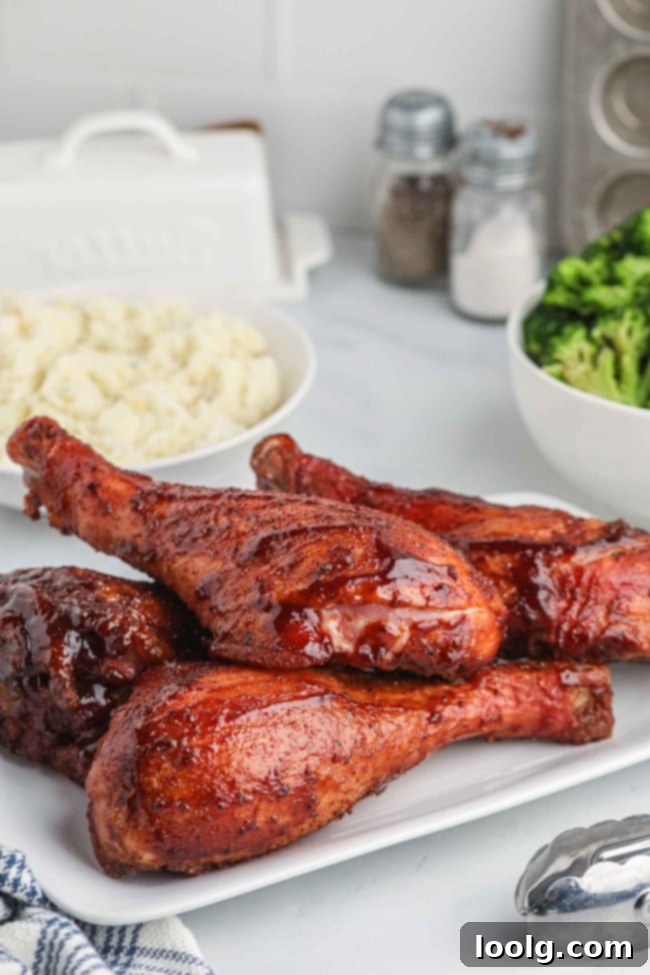
Do You Have to Brine Turkey Legs? The Undeniable Benefits
While technically you *can* smoke turkey legs without brining, it is highly recommended and, for many, an essential step in achieving the best possible results. Brining smoked turkey legs is a remarkably simple yet incredibly effective technique that profoundly enhances their flavor, moisture, and tenderness. Think of it as a culinary insurance policy against dry, bland meat.
Here’s how brining works its magic:
- Unbeatable Juiciness and Moisture Retention: The primary benefit of brining is ensuring incredibly juicy and moist turkey. Through the process of osmosis, the salt in the brine helps the turkey meat absorb and retain moisture. The salt solution also causes proteins in the meat to denature (unravel), allowing them to hold onto water more effectively during the cooking process. This means your turkey legs will remain succulent, even after hours in the smoker.
- Deeply Flavorful: Beyond just moisture, the brine infuses the turkey legs with a delicious blend of salt, sugar, herbs, and spices from the inside out. This internal seasoning goes much deeper than just a surface rub, ensuring every bite is rich with flavor, not just the outer layer.
- Exceptional Tenderness: The salt in the brine also works to gently tenderize the meat. By breaking down some of the muscle fibers, the brine makes the turkey legs more tender and less prone to becoming tough during cooking, resulting in a delightfully yielding texture.
- Enhanced Smoke Flavor: Brined turkey legs have a unique ability to absorb smoke more evenly and efficiently. The slightly altered protein structure helps the meat better cling to the smoke molecules, resulting in a more pronounced and harmonious smoky flavor that permeates throughout the turkey, leading to an incredibly flavorful crust, often referred to as “bark.”
In essence, brining elevates smoked turkey legs from good to extraordinary. Especially for beginners, it provides a buffer against overcooking and ensures a consistently superior product. If you want the most tender, juiciest, and most flavorful smoked turkey legs possible, don’t skip the brine!
What to Serve with Smoked Turkey Legs
Smoked turkey legs are a hearty and flavorful centerpiece, making them versatile for pairing with a wide array of side dishes. Whether you’re aiming for a traditional holiday spread, a casual BBQ, or something a bit more unconventional, there are plenty of delicious options to complement the rich, smoky flavor of the turkey.
Classic BBQ and Holiday Favorites:
- Creamy Mashed Potatoes: A timeless classic, mashed potatoes offer a smooth, comforting contrast to the robust turkey.
- Green Bean Casserole: Another holiday staple, its savory and crispy texture pairs wonderfully.
- Cornbread or Dinner Rolls: Perfect for soaking up any delicious juices or BBQ sauce.
- Coleslaw: A crisp, tangy coleslaw provides a refreshing crunch that cuts through the richness of the turkey.
- Baked Beans: Sweet and savory baked beans are a quintessential BBQ side that complements smoked meats perfectly.
- Roasted Vegetables: Brussels sprouts, asparagus, or a medley of root vegetables roasted with herbs add a healthy and flavorful touch.
Unique and Flavorful Pairings:
For a few non-traditional yet incredibly delicious sides perfect for the holidays or a weekend BBQ, consider these vibrant choices:
- This colorful Sunflower Seed Salad with Cranberries offers a refreshing crunch and traditional holiday flavors in a lighter format.
- Indulge in this super creamy Pumpkin Mac and Cheese. It’s so rich and flavorful, even picky eaters won’t detect the subtle pumpkin, making it a surprisingly festive addition.
- For a truly elevated side, these Smoked Au Gratin Potatoes sound absolutely amazing and would be an incredible accompaniment to these savory turkey legs, adding another layer of smoky richness.
Consider the balance of flavors and textures – a mix of creamy, crunchy, sweet, and tangy sides will create a well-rounded and satisfying meal.
Choosing the Best Wood Flavors for Smoked Turkey Legs
The type of wood you choose for your smoker plays a pivotal role in defining the final flavor profile of your smoked turkey legs. Different woods impart distinct smoky notes, ranging from mild and fruity to strong and pungent. Selecting the right wood can elevate your turkey from good to truly exceptional.
For this recipe, I opted for applewood pellets, which are known for producing a mild, slightly sweet, and fruity smoke. This gentle flavor beautifully complements poultry, adding depth without overpowering the delicate taste of the turkey. Applewood is an excellent choice for those who prefer a subtler smoke profile.
Other Great Wood Options for Smoked Turkey:
- Cherry: Similar to applewood, cherry wood offers a sweet, fruity smoke flavor. It’s slightly stronger than apple and also imparts a beautiful rich, dark mahogany color to the turkey skin, which is highly appealing.
- Hickory: If you’re looking for a more classic, robust BBQ flavor, hickory is an excellent choice. It provides a strong, smoky, and slightly bacon-like flavor that is widely loved and pairs wonderfully with poultry and pork. Use it judiciously, as too much can become overwhelming.
- Mesquite: For the most intense and bold smoky flavor, mesquite is the way to go. It offers a very strong, earthy, and distinct smoke. It’s often favored in Texas BBQ and creates a powerful flavor that stands out. Use sparingly if you’re new to it, or if you prefer a less aggressive smoke.
- Pecan: A popular choice, pecan wood offers a milder, nutty, and subtly sweet flavor, less intense than hickory but more pronounced than apple. It’s a versatile wood that works well with most meats, including turkey.
- Oak: A medium-strength wood, oak imparts a classic, earthy smoke flavor that’s not too overpowering. It’s a great all-around choice if you want a reliable, traditional smoke profile without going too heavy or too light.
- Maple: Maple provides a mild, sweet, and somewhat subtle smoke flavor. It’s excellent for poultry, offering a delicate sweetness that enhances the meat.
When selecting your wood, consider the intensity of flavor you prefer and how it will interact with your chosen rub and BBQ sauce. You can also experiment with blending different wood types to create your unique signature smoke profile.
Why Skip the Foil Pan on the Grates?
When smoking turkey legs, you might be tempted to place them in a foil pan directly on the smoker grates, perhaps to catch drippings or retain moisture. However, for truly exceptional smoked turkey legs, it’s generally advisable to place them directly on the grill grates.
Here’s why this approach yields superior results:
- Improved Airflow: Placing the turkey legs directly on the grates allows for maximum airflow around the entire surface of the meat. This ensures consistent heating and smoke circulation, which is vital for even cooking and proper smoke ring formation.
- Enhanced Smoke Exposure: Direct grate placement maximizes the turkey legs’ exposure to the smoke, allowing the meat to fully absorb those coveted smoky flavors from all sides. A foil pan can act as a barrier, diminishing the amount of smoke that reaches the bottom and sides of the legs.
- Superior Bark and Skin Development: Unobstructed airflow and smoke exposure are key to developing that desirable “bark”—a flavorful, crisp, and chewy crust that forms on the exterior of well-smoked meat. A foil pan can trap moisture, essentially steaming the bottom of the turkey legs, preventing the skin from crisping up and the bark from forming effectively.
While you want to avoid placing the legs directly in a foil pan on the grates, you will want to place a drip pan *underneath* where you’ll smoke the turkey legs. This serves several practical purposes:
- Catches Drippings: It collects any delicious fat and juices that render from the turkey, keeping your smoker cleaner. These drippings can even be used later to make a flavorful gravy.
- Prevents Flare-Ups: By catching grease, a drip pan minimizes the risk of fat dripping onto hot coals or heating elements, which can cause unwanted flare-ups and impart a bitter taste to your meat.
- Maintains Moisture in Smoker: Sometimes, adding a little water or apple juice to the drip pan can help maintain a moist environment in the smoker, which can be beneficial for longer cooks (though for turkey legs, the brine usually handles moisture quite well).
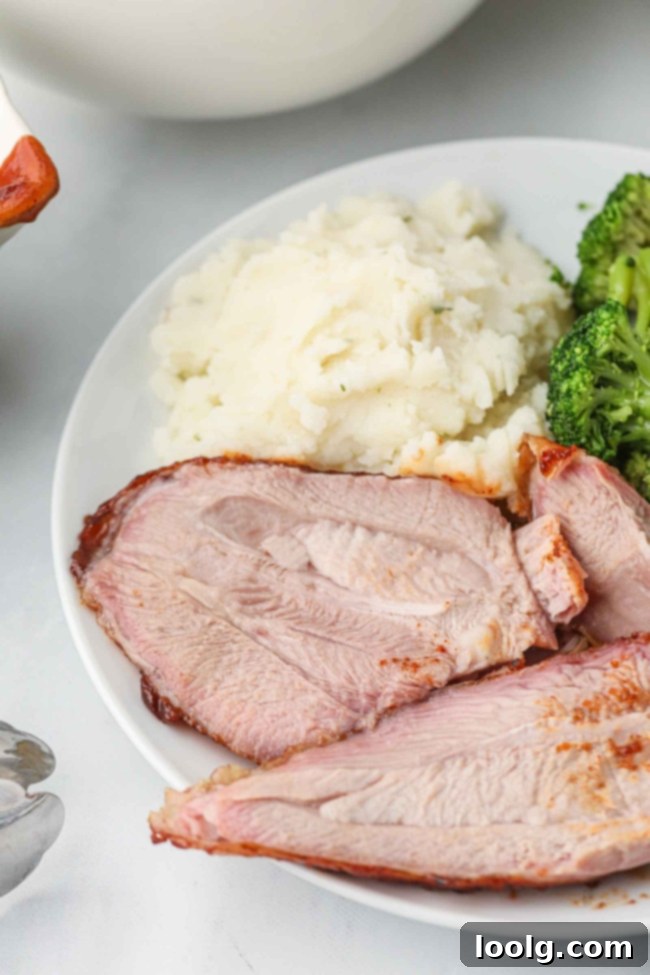
Make-Ahead Tips and Storage for Smoked Turkey Legs
Can You Make Them Ahead?
While smoked turkey legs are undoubtedly at their absolute best when enjoyed fresh, straight from the smoker, there are occasions when preparing them in advance is necessary. If serving them on the same day is not possible, you can certainly smoke the legs a day or two in advance.
To store them after smoking:
- Allow the smoked turkey legs to cool completely at room temperature, then immediately move to refrigeration.
- Wrap each leg tightly in plastic wrap to prevent moisture loss and absorb any unwanted fridge odors.
- Follow with a layer of aluminum foil for added protection.
- Place the wrapped legs in a large, airtight container or a freezer-safe bag before storing them in the fridge.
To reheat pre-smoked turkey legs: Preheat your oven to 325 °F (163 °C). Place the turkey legs in an oven-safe dish, adding a splash of chicken broth or water to the bottom of the dish to help create some steam and keep the meat moist. Cover tightly with foil and heat until they are warmed through to an internal temperature of 165°F (74°C). This usually takes about 20-30 minutes, depending on the size of the legs. Avoid overheating to prevent dryness.
How to Store Leftover Smoked Turkey Legs
Proper storage ensures your delicious smoked turkey legs remain safe and enjoyable for future meals.
- In the Fridge: Store leftover smoked turkey legs in an airtight container in the refrigerator for up to 4 days. Make sure they are cooled quickly and placed in the fridge within two hours of cooking.
- To Freeze: For longer storage, smoked turkey legs freeze exceptionally well. Wrap each leg tightly in plastic wrap, then follow with a layer of heavy-duty aluminum foil, or place them in a high-quality freezer bag, removing as much air as possible. They will maintain their quality in the freezer for up to 3 months. To thaw, transfer them to the refrigerator overnight before reheating.
Leftover smoked turkey meat can also be shredded and used in a variety of dishes, such as sandwiches, wraps, stews, chilis, or even tacos, giving you more delicious meals!
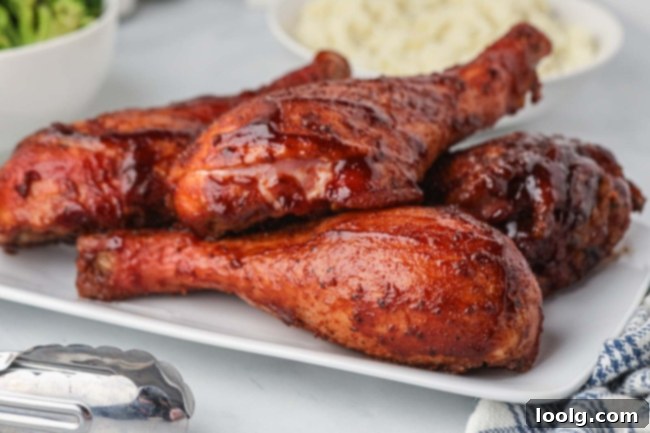
Dietary Adaptations: Gluten-Free, Paleo, and Dairy-Free Smoked Turkey Legs
One of the many great advantages of this smoked turkey leg recipe is its natural adaptability to several common dietary needs. It’s inherently a fantastic choice for those following gluten-free and dairy-free diets, and with a few simple substitutions, it can also be made paleo-friendly.
Naturally Gluten-Free and Dairy-Free
Turkey meat itself is naturally free of gluten and dairy. The primary components that might introduce these allergens are the BBQ rubs and sauces. Many commercial brands are already formulated to be gluten-free and dairy-free, but it’s crucial to always exercise caution:
- Check Labels Diligently: Always double-check the ingredient labels of your chosen all-purpose BBQ rub and BBQ sauce. Look for clear indications like “Certified Gluten-Free” or “Dairy-Free.” Some blends may contain hidden gluten in thickeners or flavorings, or have experienced cross-contact during processing in facilities that handle allergens.
- Cross-Contamination: If severe allergies are a concern, consider products that are certified gluten-free or produced in dedicated allergen-free facilities.
Making it Paleo-Friendly
To adapt this recipe for a paleo diet, the main modification involves the sugar content in the brine and any added rubs or sauces:
- Sugar Substitution in Brine: For the brown sugar in the brine, simply substitute it with coconut sugar. Coconut sugar offers a similar caramel flavor and sweetness profile, making it a perfect paleo-compliant alternative.
- Homemade Rubs and Sauces: Most store-bought BBQ rubs and sauces contain refined sugars and sometimes other non-paleo ingredients. For a truly paleo option, you’ll likely need to make your own BBQ rub and sauce from scratch. This gives you complete control over the ingredients, allowing you to use natural sweeteners like dates, small amounts of maple syrup, or honey (in moderation, if you include it in your paleo diet) in your sauces, and avoid any non-compliant additives in your rubs. Many excellent paleo-friendly BBQ rub recipes are available online, focusing on herbs, spices, and natural savory elements.
With these considerations, you can confidently enjoy these delicious smoked turkey legs, knowing they align with your dietary preferences without compromising on flavor or juiciness.
Explore More Smoked Recipes
If you’ve enjoyed the process of smoking these turkey legs and are eager to expand your repertoire of smoked dishes, here are some other fantastic recipes to try:
- Smoked Corned Beef Brisket
- Smoked Chicken Quarters
- Smoked Burgers
- Smoked Spatchcock Chicken
I genuinely hope you’ll enjoy making and savoring these incredibly tender and flavorful smoked turkey legs! If you try out this recipe, I’d absolutely love to hear your thoughts and experiences in the comments section below. Your feedback is greatly appreciated! Thanks for joining me on this delicious smoking adventure! 🙂
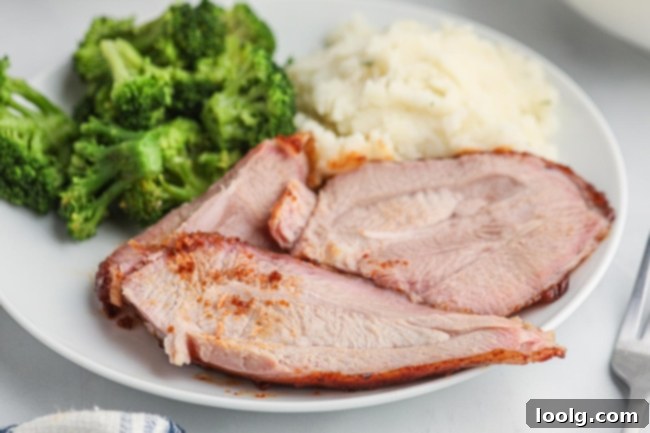
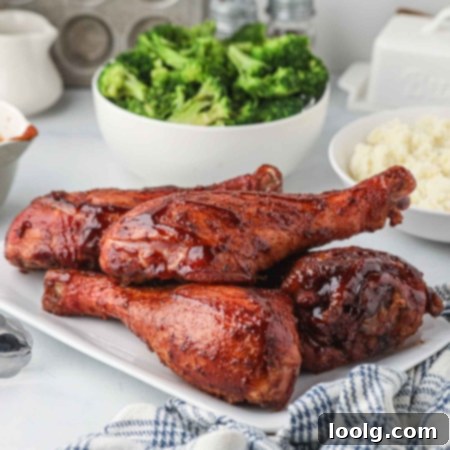
Smoked Turkey Legs
Ingredients
Brine:
- 1/2 cup (125 grams) kosher salt 1/2 cup Morton Coarse Kosher Salt, or 14 tbsp Diamond Crystal Kosher Salt, or 6 tbsp table salt
- 1/4 cup (50 grams) brown sugar or coconut sugar
- 2 bay leaves
- 1 tablespoon whole black peppercorns
- 4 cups water
- 4 cups ice water
Turkey:
- 6 turkey legs
- olive oil
- 1/2 cup (75-105 grams) all-purpose BBQ rub store-bought or homemade
- applewood pellets or cherry, hickory, or mesquite for something stronger
- 1 cup (280 grams) BBQ sauce your favorite brand or homemade
Instructions
Brine (the day before smoking):
-
In a large pot, combine 4 cups of water, 1/2 cup (125 grams) kosher salt (or your equivalent chosen salt from the conversion guide), 1/4 cup (50 grams) brown sugar (or coconut sugar), 2 bay leaves, and 1 tablespoon whole black peppercorns. Bring the mixture to a simmer over medium heat, stirring continuously until the salt and sugar are completely dissolved. Once dissolved, remove the pot from the heat.
-
Immediately stir in 4 cups of ice water to rapidly cool the brine. It is crucial that the brine is completely chilled before proceeding. Place the turkey legs in a large, non-reactive container or a sturdy brining bag. Pour the cooled brine over the turkey legs, ensuring they are fully submerged. Cover the container or seal the bag, and refrigerate for 6-12 hours (overnight for best results).
-
After the brining period, remove the turkey legs from the brine. Discard the brine. Pat the turkey legs thoroughly dry with paper towels. This step is vital for achieving crispy skin.
Day of smoking:
-
Lightly coat the dried turkey legs with olive oil. This helps the rub adhere and promotes a beautiful crispy skin.
-
Generously season the turkey legs with 1/2 cup (75-105 grams) of your preferred all-purpose BBQ rub, ensuring all sides are evenly coated. Press the rub into the skin to create a flavorful crust.
-
Preheat your pellet smoker (or other type of smoker) to a steady 225 °F (107 °C) using applewood pellets or your chosen wood flavor. Allow it to heat up for about 15 minutes with the lid closed to stabilize the temperature.
-
Place the seasoned turkey legs directly onto the smoker grates. Insert a meat thermometer into the thickest part of one leg (avoiding the bone). Smoke at 225 °F (107 °C) until the internal temperature reaches 160 °F (71 °C). This typically takes about 2 to 3 hours, but always go by temperature, not time.
-
Once the turkey legs reach 160 °F (71 °C), brush them generously with 1 cup (280 grams) of your favorite BBQ sauce. Immediately increase the smoker temperature to 275 °F (135 °C). Continue smoking the legs, allowing the sauce to caramelize and thicken, until the internal temperature reaches a final 175 °F (80 °C). This stage usually takes an additional 30 to 45 minutes.
-
Remove the smoked turkey legs from the smoker and transfer them to a clean cutting board or platter. Loosely tent them with aluminum foil and let them rest for 20 minutes before slicing or serving whole. This resting period is crucial for redistributing the juices, ensuring maximum moisture and tenderness.
-
If you have any leftovers, allow them to cool completely. Then, refrigerate in an airtight container for up to 4 days or freeze for up to 3 months.
Notes
- The grams for the BBQ rub will vary depending on the density of your specific rub brand or homemade blend. Aim for a generous, even coating.
- If you’re following a paleo diet, it’s generally best to make your own rub and BBQ sauce, as most commercial brands contain added sugars and non-paleo ingredients.
- For dairy-free or gluten-free diets, always verify the ingredient labels of your store-bought rubs and BBQ sauces to ensure they are compliant and avoid cross-contamination.
- Please note that providing an exact nutritional estimate for recipes involving brining and smoking (where significant amounts of brine/sauce drip off during cooking) is inherently difficult and can vary greatly. Factors like turkey leg size and specific rub/sauce ingredients also contribute to variability. If precise nutritional information is important for your diet, it is recommended to weigh your specific ingredients and calculate the nutritional data yourself for the most accurate figures.
